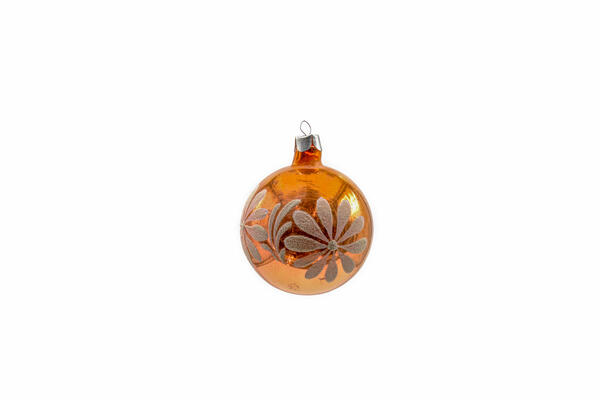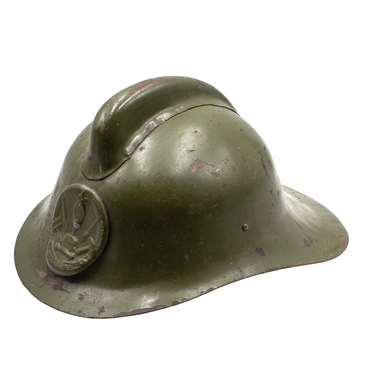The museum houses a collection of baubles made in the 1970s at the plant named after the 50th anniversary of the USSR. The bauble ‘Ball’ was donated to the museum by Viktor Milomayev, a Kotovsk resident.
The tradition of decorating a Christmas tree was started in the early 17th century in the Baltic States and Germany. The decorations were simple and reminiscent of Christian images. At first, tree branches were adorned with apples that symbolized the fruit of the Tree of Knowledge, as well as with burning candles, which signified the sacrifice of Jesus Christ and angelic purity. At the top of a spruce, people placed an ornament symbolizing the Star of Bethlehem. Various gingerbread figures, cookies and waffles served as a reference to unleavened bread, an invariable attribute of the communion rite.
Over time, more durable decorations came about: craftsmen gilded fir cones, made paper flowers and cotton wool ornaments. Legend has it that one year Germany had a poor harvest of apples, prompting people, that were looking forward to decorating Christmas trees, to turn to glass blowers asking them to make glass fruit for the holiday. That led to bright balls eventually replacing real fruit and becoming the main Christmas tree decoration, and as time went on, German craftsmen began to create other figures from glass.
In Russia, fir trees as an attribute of Christmas appeared in the first half of the 19th century in the houses of German immigrants in St. Petersburg. By the 1840s, the tradition to decorate Christmas trees was established everywhere in the country. Baubles still were not produced in Russia, so people had to order them from Europe. There were also hand-made cardboard decorations, which most often looked like small dolls with paper faces and bodies made of lace, fabric and beads. Figures of angels, children, sailors, and clowns were created with the help of cotton wool wound on a wireframe. Velvet or papier-mâché fruit ornaments could be seen on Christmas trees as well.
It was not until the early 20th century when a designated plant was launched in the town of Klin, that Russian-made Christmas decorations came into existence. At first, artel workers only blew glass figures ordered for pharmacies, but during the First World War, captured Germans taught the craftsmen to create various decorations.
In the 1970s, the Kotovsk plant named after the 50th anniversary of the USSR added a production facility of consumer goods, including Christmas baubles. Artists developed designs of the decorations, as well as came up with ideas of what to depict on them. At first, future ornaments looked like long glass blanks, which then were heated and blown into the necessary shape and after that painted by hand.
The tradition of decorating a Christmas tree was started in the early 17th century in the Baltic States and Germany. The decorations were simple and reminiscent of Christian images. At first, tree branches were adorned with apples that symbolized the fruit of the Tree of Knowledge, as well as with burning candles, which signified the sacrifice of Jesus Christ and angelic purity. At the top of a spruce, people placed an ornament symbolizing the Star of Bethlehem. Various gingerbread figures, cookies and waffles served as a reference to unleavened bread, an invariable attribute of the communion rite.
Over time, more durable decorations came about: craftsmen gilded fir cones, made paper flowers and cotton wool ornaments. Legend has it that one year Germany had a poor harvest of apples, prompting people, that were looking forward to decorating Christmas trees, to turn to glass blowers asking them to make glass fruit for the holiday. That led to bright balls eventually replacing real fruit and becoming the main Christmas tree decoration, and as time went on, German craftsmen began to create other figures from glass.
In Russia, fir trees as an attribute of Christmas appeared in the first half of the 19th century in the houses of German immigrants in St. Petersburg. By the 1840s, the tradition to decorate Christmas trees was established everywhere in the country. Baubles still were not produced in Russia, so people had to order them from Europe. There were also hand-made cardboard decorations, which most often looked like small dolls with paper faces and bodies made of lace, fabric and beads. Figures of angels, children, sailors, and clowns were created with the help of cotton wool wound on a wireframe. Velvet or papier-mâché fruit ornaments could be seen on Christmas trees as well.
It was not until the early 20th century when a designated plant was launched in the town of Klin, that Russian-made Christmas decorations came into existence. At first, artel workers only blew glass figures ordered for pharmacies, but during the First World War, captured Germans taught the craftsmen to create various decorations.
In the 1970s, the Kotovsk plant named after the 50th anniversary of the USSR added a production facility of consumer goods, including Christmas baubles. Artists developed designs of the decorations, as well as came up with ideas of what to depict on them. At first, future ornaments looked like long glass blanks, which then were heated and blown into the necessary shape and after that painted by hand.



